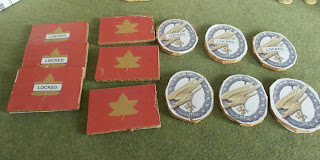Chain of Command starts with an interesting process called the Patrol Phase, which will set the deployment points for the two forces when actual play begins. It's played out using patrol markers, which represent the two forces maneuvering around the battlefield until they make contact. It's a great way to help represent the "empty battlefield" which has been a feature of warfare since at least the Boer War, and which is hard to depict on the wargame table as we just love to show off our beautifully painted toys!
Each side gets a number of patrol markers, typically three or four, but potentially up to six. The Canadians are represented by the 1st Canadian Division's "Red Patch" and the Germans by the Fallschirmjäger badge.
The markers can be flipped once locked, which happens once the marker ends up within 12" of an enemy markers. These markers are pretty big, and moreover the Canadian and German markers are different sides. It'll be important to measure from the centre of each marker. Measuring from the edges will potentially give one side or the other an advantage of a few inches.
They are really sloppy, so if I get a chance I'll redo them.


No comments:
Post a Comment